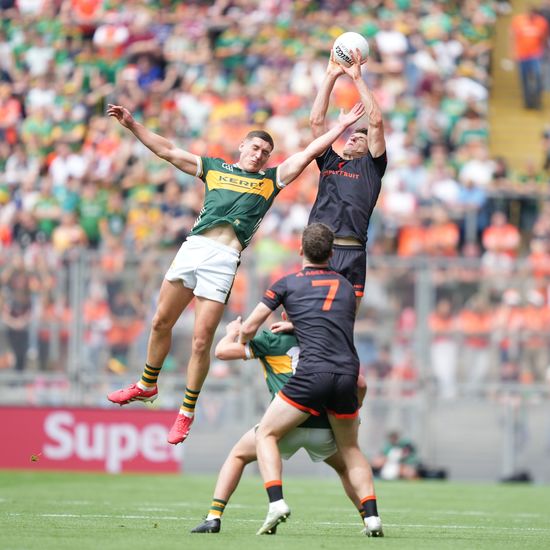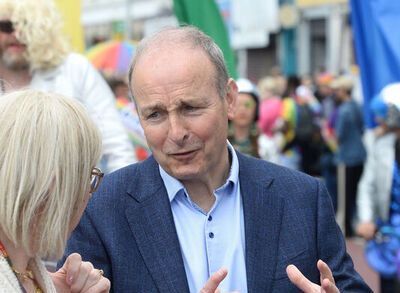The Grand Canal entrance to Cathal Brugha Barracks, Dublin
PHOTO: PETER MCDERMOTT
By Peter McDermott
pmcdermott@irishecho.com
The last act of the 1916 Rising commemoration ceremony outside the General Post Office on Easter Sunday was the 21-Gun Salute.
As I mentioned in the report from the scene on Page 1 last week, the army narrator gave some background as to the origins of this tradition.
But it was the only reference to a martial past, other than the Proclamation’s alleged six times over 300 years that the Irish people asserted in arms the right to “national freedom.”'
In his GPO diary, poet and Proclamation signatory Joseph Plunkett adopted the style of the French Revolution with references to Day One, and so on, of the Republic. The ceremony of March 27, which was very impressive and went off without a hitch, took a similar approach.
It was hard to credit that at the moment of the Rising, there were 130,000 Irishmen under arms in Europe, which doesn’t count those fighting with the Dominions, or the many more in other years, including those who joined up in America. Or that three of the seven signatories of the Proclamation had close personal or family ties to the military and/or the police.
For a century and a half, there was a stark reminder in stone of the island’s military past, one which also gave Dublin, as Senator Owen Sheehy-Skeffington said in the 1960s, “its internationally known appearance.”
Rebel fighters in 1916 found Nelson’s Pillar useful for cover. How evocative a structure of Ireland’s past it would be if it were still standing. But, alas, on the night of March 8, 1966, all of the neuroses of extreme nationalism were packed into one small bomb.
Sheehy-Skeffington, whose father was shot in 1916 – more about him below – said the bomber made the city less like an “ancient city on the Liffey” and more like Birmingham (the home city, incidentally, of Patrick Pearse’s stonemason father).
It should be said that a broad range of 20th century nationalist opinion, from Brendan Behan to the rightist Blueshirts, believed the very existence of the Pillar gave offense.
W.B. Yeats, though, was among its defenders. "The life and work of the people who built it are part of our tradition," he said.
Likewise, James Joyce had no problem with the Pillar, appreciating its place in Dublin folklore. He was part of the moderately nationalist current within literature – which includes up to our time a writer like the late John McGahern – whose attitude seemed to be: “Irish history is complicated; get used to it.”
The Pillar was built a full 30 years before Nelson’s Column in London’s Trafalgar Square, which doesn’t have the interior stairway or viewing platform of the Dublin original.
Just four years before the 1809 birth of the Pillar, hundreds of Irish Catholics had participated in the Battle of Trafalgar. Many thousands of Irishmen overall would fight in the wars against Napoleon.
Afterwards, facing the prospect of famine at home, English, Irish and Scottish soldiers were recruited in London to fight in South America with Simón Bolívar, AKA the Liberator.
Those who survived disease on the ships getting there proved crucial to victory. In 1821, the Liberator called those mercenaries the “saviors of my country.”
Bolívar, who has a monument dedicated to him in Central Park, would have approved mightily of Nelson’s Pillar and likely also of a later statue on Sackville/O’Connell Street to that other Liberator, Daniel O’Connell, the founder, it could be said, of the Irish Catholic nation.
At the time the Pillar was constructed, modern concepts of patriotism and republicanism were well-established internationally, but the idea of a nation coinciding with a specific geographical area, or an historic community moving through time, was in its infancy.
Irish historians have warned in recent weeks that when looking back 100 years it’s hard to comprehend the passions and sensibilities of the time. How much more difficult, then, to go back another century again to divine what the common people thought in 1809.
“They are dancing in the streets of Paris. People are dancing in celebration of a revolution, a revolution that took place such long time ago that only a historian can have faith that it actually took place,” wrote German foreign correspondent Joseph Roth in reference to July 14, 1925, the 136th anniversary of the storming of the Bastille.
But, to be fair, the commemorative process in Ireland has involved more than historians; it has encouraged ordinary people to connect with history through family stories.
In that spirit during my short stay in Dublin, I went to see the Grand Canal gate of Cathal Brugha Barracks, formerly Portobello Barracks. During Easter Week, 1916, my mother’s father, then just turned 13, was at the canal near the barracks gate with a couple of friends hoping to collect some minnows – known locally as pinkeens – when he was witness to some of the action surrounding the Francis Sheehy-Skeffington tragedy.
The pacifist, socialist, feminist and nationalist Sheehy-Skeffington was attempting to stop looting when he was arrested with two fellow journalists, both unionists, and, a short time later, marched through that gate facing onto the canal. The next day, April 26, all three journalists were put to death before a firing squad at Portobello Barracks, at the orders of the arresting officer, Capt. J.C. Bowen-Colthurst. The scandal of the killings reached Parliament. Sheehy-Skeffington’s widow Hannah (an aunt of Conor Cruise O’Brien) toured America in 1917 with her story and was thereafter a prominent republican activist. Not so well known was the fact that her husband had condemned the growing militarism of the Irish Volunteers and of his friend Thomas MacDonagh in an opinion piece in 1915, which he turned into a pamphlet.
In the couple of years following the Rising, my grandfather’s older brother and sister joined the independence struggle, and then he, too, became “involved,” as the saying went. His siblings, however, would actively support the Treaty, his brother becoming an officer in Michael Collins’s new army, which took over at Portobello and elsewhere; my grandfather was on the other side, de Valera and Cathal Brugha’s, in the Civil War and before he reached the voting age of 21 had spent over a year in the internment camp at the Curragh.
That he had the right to vote at all (his preferences later were Larkinite) is hardly insignificant. The Irish revolution took place against a backdrop of almost 100 years of constitutional change, which included a series of acts of Parliament – notably in 1832, 1867 and 1884, but also others up through 1918 – that gradually but radically reformed the electoral system in tandem on both islands.
Before any of that, London had been supporting the Catholic Church institutionally as a buffer against French-style revolutionary ideas; and governments, in response to upheaval a century later, initiated Land Acts that helped make 20th century Ireland one of the more conservative places in Western Europe.
Little wonder that in the 1920s, government minister Kevin O’Higgins could speak for much of his generation when he said that they were "the most conservative-minded revolutionaries that ever put through a successful revolution.”









